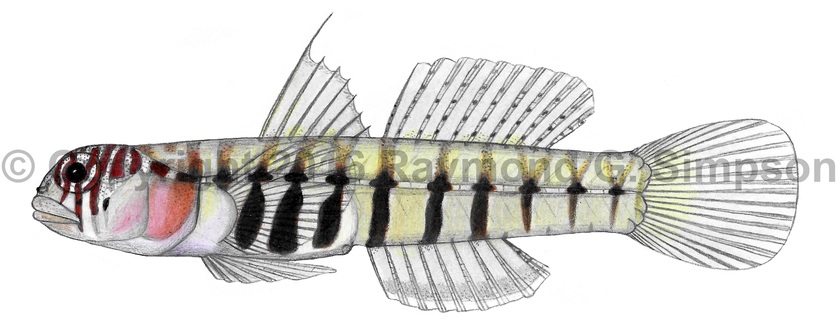
Common Name
Semiscaled Goby
Year Described
Ginsburg, 1939
Identification
Dorsal Fin: VII, 10-12 (usually 11)
Anal Fin: 8-10 (usually 9)
Pectoral Fin: 15-16
Caudal Fin: 17 (segmented)
Vertebrae: 11 precaudal, 17 caudal; 27 total
Body elongate with a blunt snout. Two preopercular pores. Scales found on the rear part of body. Four modified basicaudal scales. Last 2 dorsal spines separated more than the anterior five. Anterior spine may be elongate in mature males. Pelvic fin forms a fused disk.
Color
Body translucent yellowish to whitish, with 8-10 dark body bars that darken to black on the lateral midline and grade to golden on top and bottom. Gut area bright white with three large black blotches that run in line with the body bars in that region. Head with bright pink in the gill region and large red melanophores. Top of head internally bright red and white. Eye banded. Fins are translucent and peppered with melanophores.
Size
Maximum size to 19mm SL.
Habitat
Shallow coral reefs, usually in sand canyons with limestone and algae walls.
Range
Caribbean Sea from the Bahamas to the Lesser Antilles.
References
Böhlke, J. E., & Robins, C. R. 1960. Western Atlantic gobioid fishes of the genus Lythrypnus, with notes on Quisquilius hipoliti and Garmannia pallens. Proceedings of the Academy of Natural Sciences of Philadelphia, 112, 73-101, Pls. 101-103.
Böhlke, J. E., & Robins, C. R. 1968. Western Atlantic seven-spined gobies, with descriptions of ten new species and a new genus, and comments on Pacific relatives. Proceedings of the Academy of Natural Sciences of Philadelphia, 120, 45-174.